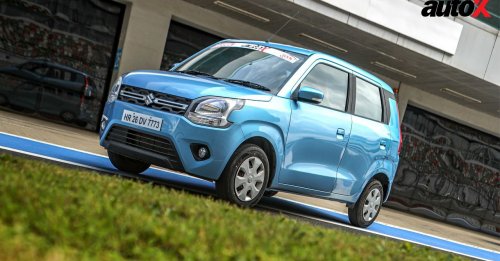![Maruti Suzuki insignia]](https://static.autox.com/uploads/2023/12/Maruti-Suzuki-Jimny-Front-Tyre.jpg)
In my last long-term report, I mentioned that we had replaced the stock Bridgestone H/T tyres (195/80-15) of our long-term Jimny with a set of fatter Apollo Apterra AT2 tyres (225/70-15). After rigorously testing these tyres for over two months now, we have managed to clock considerable mileage with the new rubber. So, it’s now time for us to provide you with a comprehensive tyre test report, as promised. Here’s everything you need to know if you plan to upsize the tyres of your Jimny.
Acceleration: Not great, not terrible
The Jimny isn’t a fast vehicle, and given its intended purpose, metrics like top speed and 0 – 100km/h acceleration don’t really matter. Still, we did manage to do a couple of acceleration runs with both sets of tyres to give you some perspective. With the standard tyres, the Jimny MT took close to 18 seconds to hit the 100km/h mark, while with the heavier and wider Apollos, the Jimny experienced a bit of a slowdown, adding a second and a half, resulting in around 20 seconds for the same stint. So, as expected, the wider AT tyres did affect the acceleration, albeit not by much as we initially anticipated. Also, in the real world, it’s hard to tell this difference because the Jimny is not what you would call a fast vehicle.
Handling: Night and day difference!
In terms of handling, the Apterras truly outshine the stock tyres. We tested both sets of tyres back-to-back at the ICAT test track and found that there was a night and day difference in the Jimny’s handling abilities with each set of tyres. The Apterra-equipped Jimny was a full three seconds faster over a lap than the Jimny with standard tyres (1:22 vs 1:25). The track featured high-speed banking, hard braking spots, and a slalom section. So, the question is – how did the fatter, wider, and heavier AT tyres manage to make the Jimny faster than the lighter road-biased tyres? Traction – that’s the one-word answer. With the Apollo tyres, the roadholding becomes much better, given the considerable improvement in grip levels. In the standard Jimny, the moment you take a corner aggressively, it quickly turns into a tripod, with its front (inside) wheel refusing to stay grounded.
The more you turn the wheel, the more the car leans on its side, resulting in uncontrollable body roll and understeer. The front end really struggles for grip, and the handling seems vague. With the wider Apollos, though, it’s a totally different story. There’s more grip and feedback from the front end, and it’s more responsive to your inputs. Honestly, you don’t even need a test track to figure this out – it’s quite evident even in a parking lot. On winding roads, the front end stays glued to the surface, offering increased lateral grip with minimal sidewall flex. The only downside here is that steering feels a shade heavier than before, and it returns to the centre quite aggressively, which may require some time to get accustomed to.
Ride Quality: Hard Knuckled
While the standard Jimny’s ride quality is stellar and almost magic-carpet-like for a ladder-frame off-roader, this is no longer the case with the Jimny equipped with the fat AT tyres. Compared to the skinny Bridgestones, the hard-knuckled Apollos affect the ride quality adversely, owing to their stiffer sidewall and block-pattern tread. The ride quality, while acceptable, is not as absorbent or plush. Instead, it’s a bit bouncy, particularly noticeable in the rear suspension.
Also, a lot more tyre noise filters into the cabin. That said, in the larger scheme of things, we think it’s a happy trade-off because even with the AT tyres, the Jimny’s ride quality is still one of the best among ladder-frame SUVs.
Off-Road: Claws out
Simply brilliant! The AT tyres make the Jimny an even better off-roader, for that’s exactly what these tyres are supposed to do. On dirt and slush, these tyres exhibit enhanced composure and surefootedness, with improved grip levels proving invaluable in pulling you out of tricky spots. Sure, the Jimny’s brilliant 4x4 hardware makes it a remarkable off-roader, even with the H/T tyres. But with the AT tyres, you get a better feel of traction. Plus, it doesn’t feel skittish going over rocks and boulders.
Also Read: Goodyear Tyre Feature: Testing to The Limit
Braking & Stability: Stops ON a dime!
A larger contact patch results in more grip and more friction, leading to a reduced braking distance. It’s no different here. However, the Apollos not only offer a reduced stopping distance but also a surefooted feel while bringing the Jimny to a halt from high speeds. Similarly, at highway speeds – 100km/h or thereabouts – the Jimny feels a lot more stable than it does with OE-spec rubber. Plus, with the AT tyres, there’s no need for frequent steering corrections, which is a big relief during long highway journeys.
Bye or Buy?
If you ask us, we would wholeheartedly recommend upsizing the tyres of the Jimny, for the difference between the stock rubber and the Apollos is quite notable. Except for the ride quality, these tyres have significantly improved every aspect of the Jimny’s driving dynamics. Sure, they aren’t cheap at Rs 7,900 apiece, but if there’s one modification you must consider for your Jimny, it should be the tyre upgrade. As mentioned earlier, these tyres make the Jimny feel like a completely different car. And, also, did I mention how cool and macho it looks with fatter tyres?


























Write your Comment